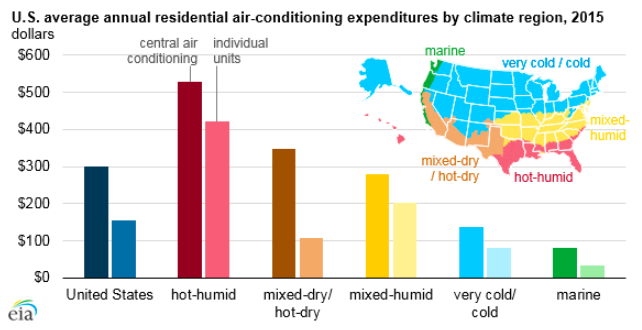How Much Money Do You Pay to Cool Your Home?
As shown in the graph below, a household’s cooling cost is greatly dependent on the home’s location. For example, homes in the southeast region of the US average over $500 per year in cooling costs, and homes in the southwest average about $350 per year.

Source: EIA
The cost can also significantly depend on whether your home has central air or individual room units (like window units). About 65% of households use central air conditioning systems, and about 25% use individual units. And it turns out that window units are generally cheaper than central air, as long as you turn the systems on only when you are occupying the room. Because the window units only cool one room at a time compared to an entire house, their average annual costs are only $156 per year. This is much lower than the $299 per year average for households with central air.
Why Do Humid Climates Have Higher Cooling Costs?
First, let’s talk about relative humidity. Relative humidity measures how much moisture is in the air compared to how much moisture the air could hold at its current temperature. So if the relative humidity is 40%, that means the air is holding 40% of the water vapor that it can hold before the air is fully saturated.
Air at higher temperatures can hold more water vapor than air at lower temperatures. So when air is cooled in our homes, its relative humidity increases. But since humans are most comfortable in relative humidity levels between 40-60%, cooling systems in humid climates have to both cool and dehumidify air to maintain indoor comfort.
So in the humid southeast, cooling expenses can be higher because the system needs more energy to both cool and dehumidify the air.
Different Climate, Different Cooling System
Because cooling needs are different based on climate, different types of cooling systems work better depending on where you live.
In hot, dry climates, systems called evaporative coolers tend to work well. They evaporate water to cool and humidify the surrounding air, which greatly increases human comfort. Plus, the average household with an evaporative cooling system spends only about $161 per year to operate it.
In moderate climates that have both a heating and cooling season, heat pumps tend to work well. There are a few different categories of heat pumps: air source, water source, and ground source. These just refer to what medium the heat pump is using to transfer heat in or out of your home.
Since the ground temperature is pretty constant all year, the ground source heat pumps tend to be the most efficient. They’re also a bit more expensive, but there are usually a ton of rebates or tax credits available that help offset their initial cost. And once you have a heat pump installed, you can save 30-60% in energy costs per year.
The most common type of cooling system found in US homes is a split system. For these households, upgrading to an EnergyStar model can reduce cooling costs by up to 50%, even for systems that are just over 10 years old.
How Can You Reduce Your Cooling Expenses?
Tighten Your Building Envelope
It’s super important to tighten your building envelope BEFORE upgrading your cooling system. Tightening your building envelope reduces how much energy your cooling system needs to cool your home. This means you can buy a smaller sized cooling system to meet your cooling needs. And smaller systems are generally cheaper than larger ones. If you have a cooling system that’s too big, it won’t operate efficiently; if you have a cooling system that’s too small, it won’t be able to maintain indoor air comfort.
Check out our episode on building envelope to learn more!
Make Yourself “Cooler”
The easiest and cheapest way to reduce your cooling needs is to wear light clothing. Wear shorts and a t-shirt over the summer, even when you’re inside.
Another strategy is to spend your time in naturally cool spaces. For example, basements and rooms in north sections of homes tend to be cooler than other areas of a home. This is because heat rises and because, in the northern hemisphere, the sun does not come through windows that face north, respectively.
Use a Fan
A fan can make the room temperature feel anywhere from 4-10 degrees cooler. Plus, fans require only about 10% of the energy costs that are needed by most cooling systems.
It’s important to remember that fans make people feel cool, but they don’t actually reduce the air temperature. So fans cool people, not rooms, which is why you should turn your fan off in unoccupied rooms.
Maintenance
Proper maintenance of your cooling systems is the key to maintaining their efficiency. Make sure to replace or clean filters as needed, because dirty filters can increase cooling expenses by up to 7%.
Upgrade
Consider ditching central air systems for individual room units! But regardless, make sure your system is EnergyStar certified. See the section above for numbers about savings!
Disclaimer: Please consult with a professional before making any upgrades to your cooling system, ductwork, or home. Any and all upgrades should maintain proper health, safety, and sanitation levels within your homes. It All Adds Up and its affiliates are not responsible for any household damage or personal injuries that should occur from following any suggestions from It All Adds Up.
HAVE QUESTIONS?
Do you have a certain topic that you would like us to talk about?
READY TO SAVE?
Check out our latest episodes for tips and tricks to save you money!
SUBSCRIBE
We send out a weekly email to our listeners that reviews that week’s episode! To join our mailing list, enter your email in the box below and hit “Subscribe.” Make sure to add [email protected] to your contact list.
ABOUT US
Get to know more about us and the team behind our podcast!
